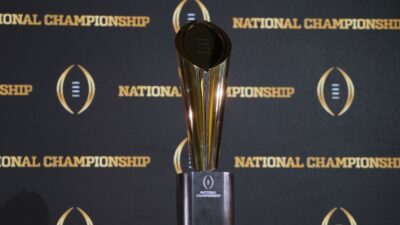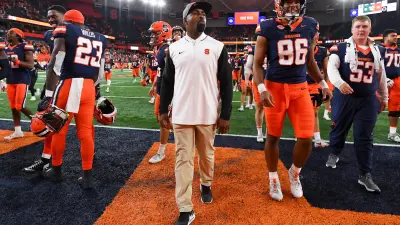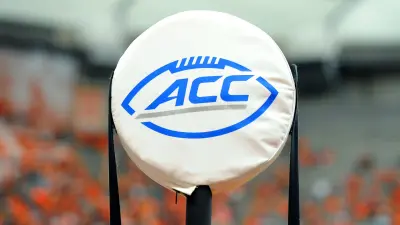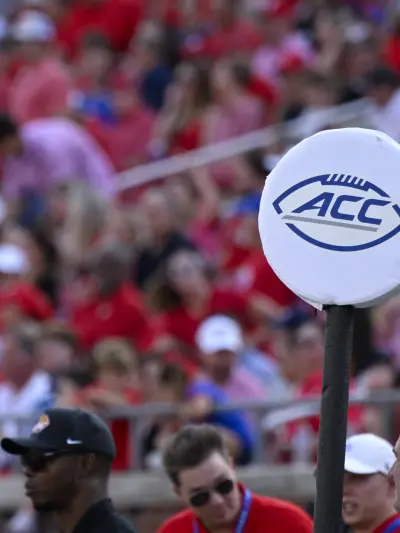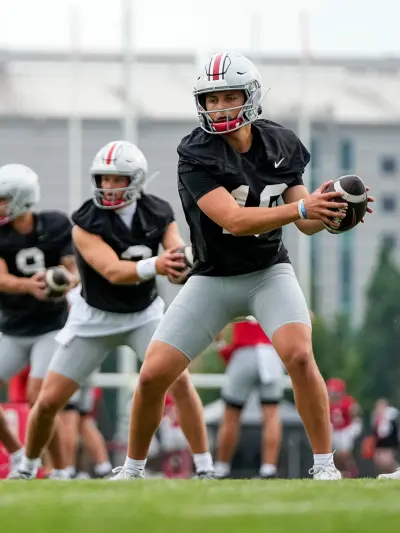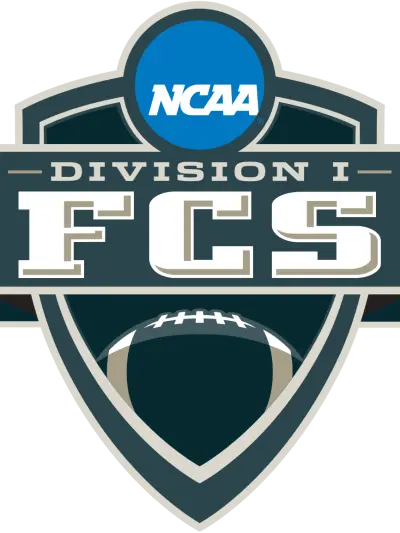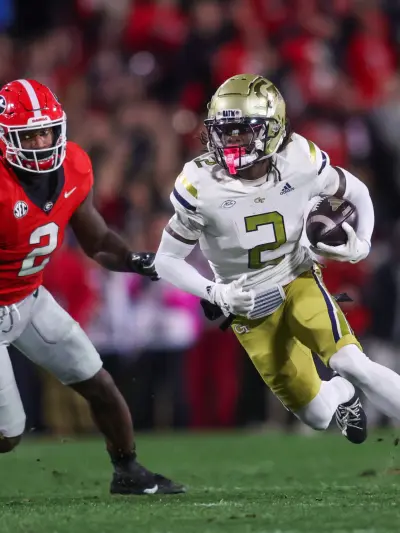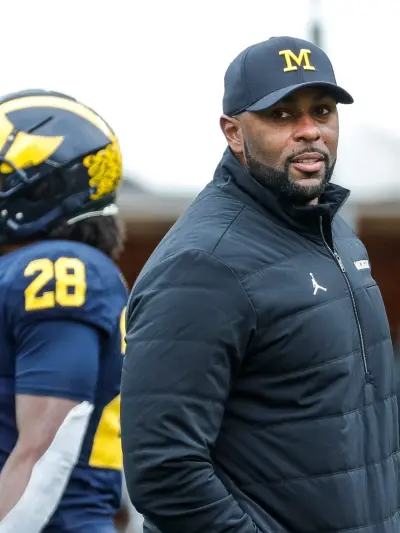By Rock Westfall
The Big Ten and SEC are plotting a 14-team College Football Playoff. A six-year, $1.3 billion agreement with ESPN, which remains unsigned, would include the Power Four conferences and the Group of Five. However, a 16-team format would be better.
16 Teams Offer Superior Potential vs. Cloddish 14-Team Model
This week, momentum is building for a 14-team College Football Playoff model starting in 2026. The current model being touted is a 3-3-2-2-1-3 model, meaning three automatic bids for the Big Ten and SEC, two automatic bids for the Big 12 and ACC, one automatic bid for the Group of Five, and three at-large bids. One of those at large bids would be taken by Notre Dame if they qualify as a playoff team. Thus, in most years, the reality is that there would be only two at-large bids.
If the CFP is going to expand from 12 teams in the next two years to 14 teams in 2026, it may as well go to a neat and clean 16 teams instead. With the 14-team model, the top two seeds (and TV draws) would get a bye week. That is an astonishing wasted opportunity from a business perspective.
With the exclusion of the two best teams, likely name-brand superpowers that TV viewers want to watch with massive fan bases that would sell out their home stadiums, the potential for leaving a lot of revenue on the table is considerable. Not offering marquee brands to the public at iconic college football stadiums is nonsensical.
Does ESPN want major programs like Michigan, Ohio State, Georgia, Alabama, Florida State, Texas, Oregon, etc., sitting at home in the first round or generating TV viewership instead? The question answers itself.
A proposed 14-team playoff starting in 2026 would include 11 automatic bids based on conference membership because of money. Is cluster**** one word or hyphenated? Here's a unique concept: the top 14 ranked teams, regardless of conference, make the playoff https://t.co/GorpJdbaRU
— Brett McMurphy (@Brett_McMurphy) February 29, 2024
More Sports News
The Unimpeachable Case for 16 Teams
With a 16-team model, it would be easy to schedule an eight-game first round with all teams involved and each game hosted at an on-campus venue by a Top-Eight seed. A second round played at on-campus venues would be logical as well. College Football’s Final Four could then tie into New Year’s Day bowl games, with the national championship to follow a week or two later.
Almost certainly, the CFP will eventually end up with 16 teams anyway. Part of the reason for the currently proposed 14 is that the Big Ten and SEC while muscling to hog most of the automatic bids with the additional potential for additional at-large bids, want to appear fair and inclusive to the other leagues. Instead, the Superpower Two are coming off as arrogant, condescending, and paternalistic. They are because they can.
The Big Ten and SEC have the power to do what they want. This bullying capability includes currently angling to rig the CFP format with automatic byes and guaranteed 1-2 seedings. Equally, if not more important, is that Big Ten and SEC will get much larger slices of the financial pie.
Indeed, the Super Two wants to give off the appearance of playing nice while gaming the system, regardless of the merit of their teams.
Column: As if the Wednesday power grab for guaranteed CFP bids weren’t enough, now the Big Ten and SEC want guaranteed byes. Obnoxious gluttony. https://t.co/cxWVwDXCSN
— Pat Forde (@ByPatForde) March 1, 2024
There is no doubt that the teams who would barely miss the cut out on a 14-team playoff will go ballistic, especially if they were left out in favor of Notre Dame or SEC and Big Ten at-large teams.
Such a scenario would be reminiscent of what happened to undefeated ACC champion Florida State in 2023 when it was left out in the cold in favor of one-loss Alabama.
Instead, expanding to 16 teams would offer more margin for error for all concerned and greater access to the non-Superpower Two.
The 16-team model gives college football a phenomenal opening round with all teams in action at regular college stadiums instead of antiseptic NFL venues.
And in the naïve hope that anyone still cares about fans, keeping games on campus for the first two rounds makes it significantly more affordable and convenient. Also, there is the added benefit of a raucous playoff atmosphere on campus compared to the sterile, corporate, TV studio environment of neutral sites.
These are the Group of 5 teams you may see in the College Football Playoff next season.
Who do you think makes it? pic.twitter.com/v9SUFa7AGU
— CFBSelect.com (@CfbSelect) February 21, 2024
The Biggest Potential Hurdle and an Ironic Wild Card
The other factor that could continue to cause delays is college football’s ultimate question: What will the sport become, and who will be the governing body?
The proposed ESPN CFP deal is for $1.3 billion over six years. But if college football contracts with a breakaway of the Big Ten and SEC and, theoretically, a few more programs who join with them, the dynamics of the CFP would change dramatically.
Further complicating things is the biggest event of another sport. The NCAA Men’s Basketball tournament is the biggest money maker for the governing body by far. The NCAA has been living off March Madness for decades, much more so than football.
And because every football school also has a basketball program, many of them are annual participants in March Madness, which may tie into a reformation of the NCAA instead of a breakaway college football governing body. Unless, of course, the SEC and Big Ten decide to take their basketball and go home with their own post-season tournament.
The ultimate irony is that March Madness may save the NCAA as college football’s governing body. But even if the NCAA remains the governing body, it would have to reform itself and its rules radically. Rules that match today’s realities instead of the 1950s are mandatory. In the same way, the rules would need to be enforceable, which they aren’t now. Because of the NCAA’s tone-deaf fecklessness, college football is in perpetual lawless chaos.
Rename The CFP to Big Ten-SEC Invitational?
Of significant embarrassment to the NCAA is that SEC Commissioner Greg Sankey and Big Ten Commissioner Tony Petitti are the dynamic duo running college football. New NCAA president Charlie Baker has discovered he is powerless and is off to a befuddled start to his tenure. Thus, how much future enforcement power the NCAA would actually have is quite debatable.
Sankey and Petitti will determine whatever college football becomes, even if it is the NCAA in name only. Thus, it is up to them to lead the charge for realistic and enforceable rules. Once that is accomplished, the evolution of what the CFP becomes will be much easier.
Most likely, the CFP will sign its six-year deal for now, and then college football’s evolution will continue over that period with a more defined deal and CFP structure six years or so from now.
Can anyone say “Band-Aid?”
Change is coming to the College Football Playoff: More automatic qualifiers.
On Wednesday, CFP leaders explored a variety of new models that grant multiple AQs (10-12 total) to the four power conferences in a 14-team format with two byes.
Buckle up.https://t.co/ESdyLqiaHJ
— Ross Dellenger (@RossDellenger) February 22, 2024
